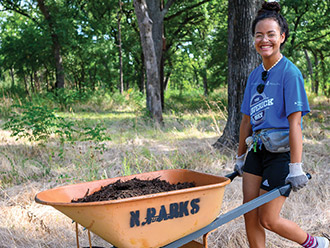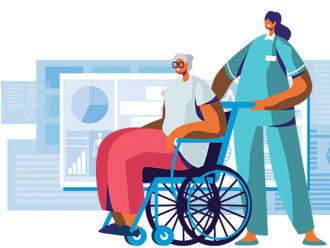In cities across the world, 2.2 billion people lack access to clean and safe drinking water, according to the World Health Organization. Some 4.5 billion do not have safe sanitation services. By 2025, half of the world’s population will be living in water-stressed areas. As the global crisis grows, UTA researchers are working across disciplines to develop both public policy and science-based solutions for supporting water quality around the world.
Their work highlights UTA’s commitment to making a global environmental impact and improving health and the human condition, both key pillars of the University’s Strategic Plan: Bold Solutions | Global Impact.
Adrian Parr, dean of the College of Architecture, Planning, and Public Affairs, captured the world’s struggle for water in her documentary The Intimate Realities of Water, which followed the everyday lives of four women living in Nairobi, Kenya. The film was shown at the Paris Climate Talks in 2015 and went on to win more than a dozen awards at independent film festivals worldwide.
“Exploding urban growth presents unprecedented challenges for water and sanitation. How can urban development enhance, rather than harm, watersheds?
That is our challenge.”
“Water is quickly becoming the new oil,” Dr. Parr says. “A finite amount is available, and we are consuming it at unsustainable rates. As it becomes scarcer, it also becomes much more valuable.”
Safe and readily available water is crucial not only for human survival, but also economic development, energy, healthy ecosystems, and more. The United Nations recognizes access to water as a global human right.
“Protecting our water supply is among the most pressing issues of the 21st century,” says Duane Dimos, UTA’s recently retired vice president for research. “UTA is well-positioned to be a global leader in groundbreaking water research that will sustain future generations.”
Thirsty and Drowning
For the first time in history, more than half of the global population lives in towns and cities rather than rural areas. By 2050, that is expected to grow to two-thirds, according to the United Nations.
“Exploding urban growth presents unprecedented challenges for water and sanitation,” Parr says. “How can urban development enhance, rather than harm, watersheds? That is our challenge.”
Parr studies these issues as part of her role as a UNESCO chair of Water and Human Settlements. Straddling the intersection of architecture, environmental activism, sociology, and philosophy, she seeks to humanize water data.
In 2019, Parr plans to release a new documentary, Thirsty and Drowning in America, which follows three Native American tribes in South Dakota, Louisiana, and Alaska as they struggle to fight the effects of climate change and water pollution. Parr says she hopes the documentary will serve as a wake-up call.
“From Africa to the United States, disadvantaged communities are struggling with water, including contamination and rising sea levels related to climate change,” she says. “We tend to be a little oblivious about what is going on here.”
Documenting
Drinking Water
Difficulties
Photographer Jon Hughes accompanied Adrian Parr to Nairobi, Kenya, to document daily life in the slums there for Dr. Parr’s documentary, The Intimate Realities of Water.



Clockwise from top: Adrian Parr, center, talks with local community leaders during the making of her documentary. Large jugs of water are filled for daily use. It is not unusual for residents to travel up to 20 minutes for clean water. Alice, a resident of Dagoretti in Nairobi, collects water.
Parr now wants to highlight issues facing North Texas, particularly population growth and the management of the Trinity River Watershed.
To provide a forum for discussion, she worked with Michael Zaretsky, Nick Fang, Meghna Tare, and Kevin Sloan, all from UTA, to develop Future Cities, Livable Futures: Watershed Urbanism, a regionwide conference focused on sustainable urban-watershed management and environmental impacts of transportation, climate change, and economic and population growth along the Trinity River Watershed.
Funded by the National Science Foundation, the conference drew approximately 200 public planners, engineers, and architects to UTA in August 2019.
“The Trinity River Watershed is in our own backyard and will be re-envisioned as a model for future urban watershed management and planning across the United States,” Parr says. “The watershed urbanism conference brings together professionals from diverse disciplines, from engineers and hydrologists to urban planners and environmental activists, to shape the future of the watershed.”
Some of the same issues will be featured prominently in an exhibition called Water and Human Settlements that Parr was invited to curate as part of the European Cultural Center’s exhibitions held in conjunction with the 2020 Venice Architecture Biennale.
The biennale, which runs from May to November 2020, is an international architecture exhibition that occurs in Venice, Italy. Featuring cutting-edge work from across the globe, it is considered one of the most important events for cultural critics, investors, and designers.
Four teams of CAPPA and UTA faculty are creating pieces that explore how water and human settlements interact, with a focus on the North Texas region.
“Dallas-Fort Worth is growing rapidly and faces enormous challenges surrounding our use and management of water,” Parr says. “The biennale will be an opportunity to bring attention to these issues and present UTA and DFW on an international stage.”
Clean Drinking Water
Non-stick cookware. Stain-resistant fabric. Pizza boxes.
These common household products share a dangerous trait. They are made with a class of chemicals—known as per- and polyfluoroalkyl substances, or PFAS—linked to various illnesses, including cancer, high cholesterol, and developmental problems in young children.
PFAS leach into our water and soil. In fact, studies show that some 6 million Americans are drinking water contaminated with the chemicals.
Hyeok Choi, associate professor of civil engineering at UTA, is developing a system that would clean up contaminated water and soil identified by the U.S. military.

Civil engineering Associate Professor Hyeok Choi
“Nearly all Americans are exposed to PFAS,” Dr. Choi says. “Once released into the environment, they do not break down easily. They have been called ‘forever chemicals.’”
The U.S. military uses foams that contain PFAS to fight hydrocarbon-based fires. In a study by the Environmental Protection Agency, researchers found contaminated soil and groundwater near the areas where the foams are made and used.
Choi received about $200,000 from the U.S. Department of Defense to devise a method to clean up the soil and water on these sites. He is working with Junha Jeon, associate professor of chemistry.
“Water is life. In addition to clean water for drinking, without adequate water there would be no electricity, no fuel, no plastics. Human life would come to a complete stop.”
Decomposing PFAS is difficult because they contain extraordinarily strong carbon-fluorine bonds. So Choi and Dr. Jeon are using technology that combines oxidation and reduction, essentially using reduction technology first to replace fluorine with hydrogen. Defluorinated PFAS are much more vulnerable to chemical oxidation and decomposition.
In addition to the chemical decomposition, Choi also uses activated carbon-based nanomaterials that first adsorb PFAS and then decompose them through oxidation and reduction.
“PFAS are used in so many of our everyday products, yet they are incredibly toxic,” he says. “This technology could help clean up the drinking water for 6 million Americans and future generations.”
Protecting Our Water
The Alpine High field lies in far West Texas in the oil-rich Permian Basin.
When Apache Corporation discovered it contained roughly 15 billion barrels of oil, it turned to UTA’s Collaborative Laboratories for Environmental Analysis and Remediation (CLEAR) to study ground and surface water quality in the region.

Kevin Schug, Shimadzu Distinguished Professor of Analytical Chemistry
Led by Director Kevin Schug, UTA’s Shimadzu Distinguished Professor of Analytical Chemistry, the laboratory is conducting baseline and ongoing studies of the water in an effort to protect the area’s sensitive ecology and water resources.
CLEAR is also evaluating the effectiveness of environmentally friendly well stimulation additives and any efficiencies that oil and gas well completions may gain from using such additives.
“This is a terrific and unique opportunity to partner with oil and gas industry experts to expand knowledge of best drilling practices,” Dr. Schug says. “This data will be useful to monitor future drilling operations in Texas and beyond.”
Water for Power
Tucked into the corner of Northeast India, the Kameng River flows 164 miles long, cutting through West Kameng.
Large pipes carry storm water from the river to a nearby power plant, Kameng Hydro Electric Plant, which provides hydroelectric power to nearby Indian communities. Pipes face frequent leaks, however, stunting their efficiency.
Mohammad Najafi, director of UTA’s Center for Underground Infrastructure Research and Education (CUIRE) is partnering with the Indian Society for Trenchless Technology to work with the government of India to solve the problem.

Mohammad Najafi, director of UTA’s Center for Underground Infrastructure Research and Education
“This research could put CUIRE on the international map,” Dr. Najafi says. “Hydroelectric power is used around the world. Making that system more efficient, environmentally friendly and cost-effective would have long-lasting benefits.”
During the 16-month project, Najafi will analyze defects in penstocks (the large-diameter pipes that transport water), then provide analysis, testing, and recommendations for repair and rehabilitation using trenchless technologies.
First, the team is working to identify where the penstocks, each about a mile long, are leaking.
“From there, we can determine what materials and methods and how much to use to best repair the system,” says Najafi. In this case, he says, carbon and glass fiber reinforced pipe are the likely choices because they are strong, do not corrode, and can be manufactured to any size.
Najafi, who has worked on previous cases in China, Brazil, and Colombia, says this project could benefit communities worldwide and the environment.
“Water is life. In addition to clean water for drinking, without adequate water there would be no electricity, no fuel, no plastics. Human life would come to a complete stop.” uta


